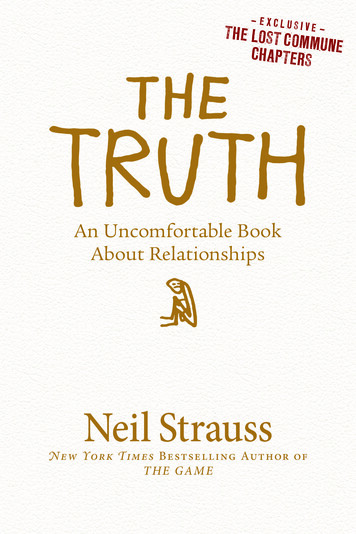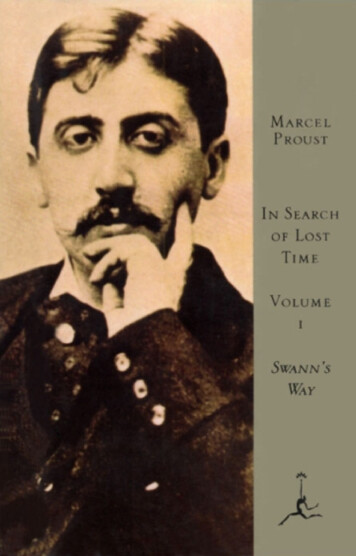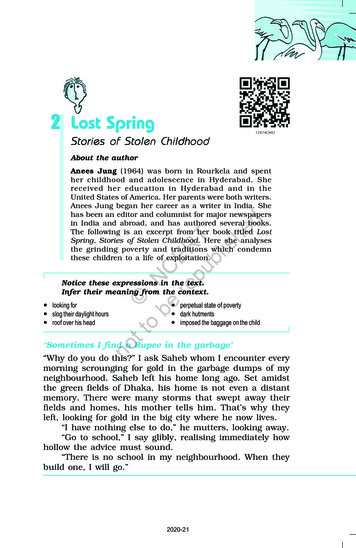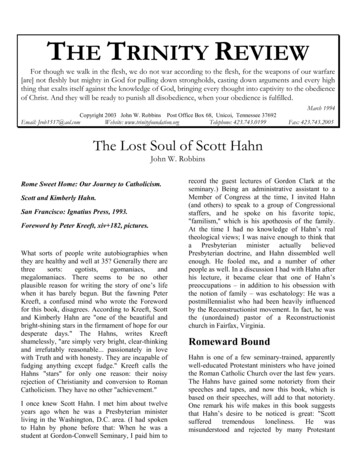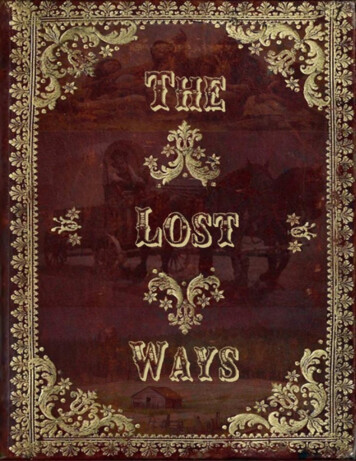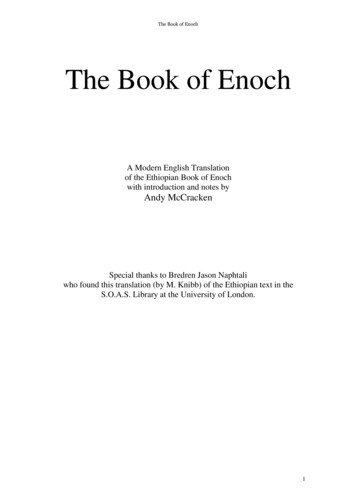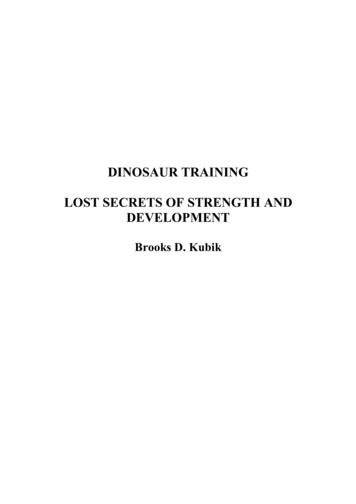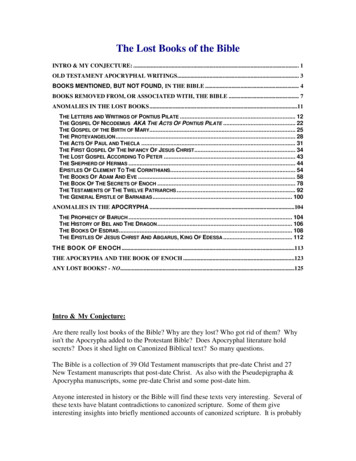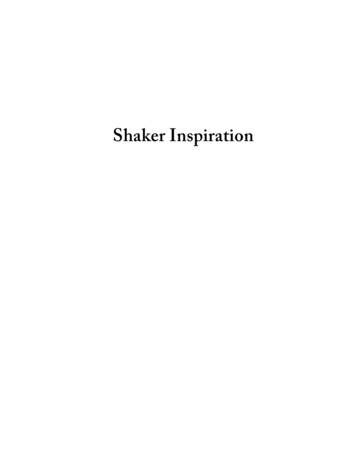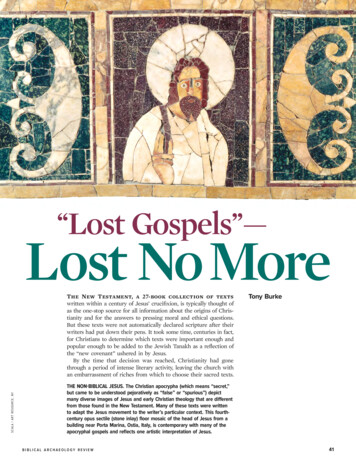
Transcription
“Lost Gospels”—Lost No MoreSCALA / ART RESOURCE, NYThe New Testament, a 27-book collection of textswritten within a century of Jesus’ crucifixion, is typically thought ofas the one-stop source for all information about the origins of Christianity and for the answers to pressing moral and ethical questions.But these texts were not automatically declared scripture after theirwriters had put down their pens. It took some time, centuries in fact,for Christians to determine which texts were important enough andpopular enough to be added to the Jewish Tanakh as a reflection ofthe “new covenant” ushered in by Jesus.By the time that decision was reached, Christianity had gonethrough a period of intense literary activity, leaving the church withan embarrassment of riches from which to choose their sacred texts.Tony BurkeTHE NON-BIBLICAL JESUS. The Christian apocrypha (which means “secret,”but came to be understood pejoratively as “false” or “spurious”) depictmany diverse images of Jesus and early Christian theology that are differentfrom those found in the New Testament. Many of these texts were writtento adapt the Jesus movement to the writer’s particular context. This fourthcentury opus sectile (stone inlay) floor mosaic of the head of Jesus from abuilding near Porta Marina, Ostia, Italy, is contemporary with many of theapocryphal gospels and reflects one artistic interpretation of Jesus.bIbLIcAL ArcHAeOLOGY reVIeW41
LoSt GoSpeLSThe considerable literature that did not make the cutconstitutes the Christian apocrypha.The word “apocrypha” means “secret,” but by theend of the second century the term had taken on thepejorative meaning of “false” or “spurious.” Christians were urged to avoid reading these rejected textsBetraying JudasOriginally looted from a tomb in Egypt, the Tchacos Codex containingthe Gospel of Judas arose on the Egyptian antiquities market withoutmuch interest, probably because of the high asking price of threemillion dollars. During this period the codex spent 16 years in a LongIsland bank vault. Eventually the Coptic papyrus came into thepossession of Zurich antiquities dealer Frieda Tchacos Nussberger.She showed it to Yale Professor Bentley Layton, who identified one ofthe texts within it as the Gospel of Judas. Yale was too fearful of thelegalities to purchase the codex, however.At this point the National Geographic Society entered the dramaas the financial backer. Withthe Maecenas Foundation ofAncient Art in Basel conserving the text and the NationalGeographic Society committed to publishing the criticaledition, all should have beenwell for the Gospel of Judas.It wasn’t.In moves that remindedsome scholars of the publication process of the Dead SeaScrolls, the National Geographic Society under a veilof secrecy contracted threeGnosticism experts to preparea critical edition of the text; allother scholars were deniedaccess to the manuscript.Things got worse when themarketing strategy deployedfor the critical edition “sold”the gospel as a possiblyauthentic historical accountwith a heroic Judas who wasrewarded with ascension intothe divine realm. The resulting publication was highly criticized for itstranslation and sensationalism.Less than two years after the release of the first edition, NationalGeographic announced a substantially revised edition that respondedto the plethora of scholarly criticism. Despite this controversy, theGospel of Judas (a page depicted left) is still a significant apocryphaltext for understanding Gnosticism.42because, as bishop Athanasius of Alexandria wrote(c. 367 C.E.), they “are used to deceive the simpleminded.” Once Athanasius and other church leadersdecided on the official canon (meaning “standard” or“rule”) of Christian scripture, the rejected texts wereapparently “lost” for centuries until the beginningof the Renaissance, when scholars journeyed to theEast in search of old manuscripts gathering dust inmonastery libraries, and more recently by archaeologists, who pulled tattered scraps of papyrus out oftombs and ancient garbage dumps.Today scholars of the Christian apocrypha arechallenging this view of the loss and rediscovery ofapocryphal texts. It has become increasingly clearthat the Christian apocrypha were composed andtransmitted throughout Christian history, not just inantiquity. And they were valued not only by “heretics” who held views about Christ that differed fromnormative (or “orthodox”) Christianity, but also bywriters within the church who did not hesitate topromote and even create apocryphal texts to servetheir own interests.1To some extent Christian apocrypha have beenwith us for as long as the texts of the New Testament. Ancient literature is difficult to date precisely, but arguments have been made, particularlyby North American scholars, for dating some of theChristian apocrypha to the first century. Such is thecase for several “lost” Jewish-Christian gospels—theGospel of the Hebrews, the Gospel of the Nazareansand the Gospel of the Ebionites—known today onlythrough quotations from these gospels made by earlychurch writers such as Jerome and Origen. TheGospel of Thomas, a collection of sayings of Jesus,may have been assembled within a few decades ofJesus’ death.Other early apocrypha are preserved in partwithin the New Testament. The gospel that scholarsrefer to simply as Q is a hypothetical document thatconsists of sayings of Jesus, some of which havebeen included in the canonical texts of both Matthewand Luke.* However, Q itself was not accepted forinclusion in the New Testament canon. We know itonly from common quotations in Matthew and Luke.Canonical texts hint of other written sources, suchas the “Signs Source” in the Gospel of John and the“Passion Narrative” incorporated into the Gospel ofMark.By the mid-second century, the four Gospels nowincluded in the New Testament had become widelyaccepted as authoritative. But many Christians*See these articles regarding Q: Eta Linneman, “Is There a Gospel of Q?”Bible Review, August 1995; Stephen J. Patterson, “Yes Virginia, There Isa Q,” Bible Review, October 1995.September/OctOber 2016
GIANNI DAGLI ORTI / THE ART ARCHIVE AT ART RESOURCE, NYLoSt GoSpeLSDON’T BE DECEIVED and simple-minded was the message that Bishop Athanasius of Alexandria gave regarding the noncanonical gospels. In his annual Easter letter (39th Festal Letter, c. 367 C.E.), Athanasius lists the 27 standard books ofthe New Testament canon. This icon of Athanasius dates to 1728 C.E. and is part of the Roger Cabal Collection.bIbLIcAL ArcHAeOLOGY reVIeW43
ALBUM / ART RESOURCE, NYL o s t G o s p e lsPAUL’S PEN PAL. One of the rediscovered apocryphaltexts details a conversation between the Roman philosopher Seneca and the apostle Paul. The stoic statesmanSeneca, famous for his works of philosophy and drama,is also known for being forced by Roman Emperor Neroto commit suicide. The famous Spanish purismo artistEduardo Rosales’s original painting of Seneca philosophizing is part of a private collectionconsidered them incomplete accounts of the life ofJesus. Gaps left by the gospel writers were filled inwith such texts as the Birth of Mary (sometimesreferred to as the Protevangelium of James), containing details of Mary’s conception and birth, andthe Childhood of Jesus (more commonly known asthe Infancy Gospel of Thomas), featuring stories ofJesus performing miracles between the ages of 5and 12. Both of these texts were extremely popularthroughout the Middle Ages and can be found in44numerous manuscripts dating from the fourth to thesixteenth centuries.Other texts recount teachings of the adult Jesus,sometimes in the form of dialogue gospels—suchas the Dialogue of the Savior and the Apocryphonof James—in which Jesus appears to the apostlesafter the resurrection and instructs them about theorigins of humanity and how to achieve salvation.These particular texts did not share the popularityof the childhood gospels; indeed, scholars did noteven know they existed until recently, when fourthcentury copies of the texts were found in Egypt.Internal disagreements led to division withinChristianity, with various groups coalescing aroundcharismatic teachers, such as Valentinus (100–160C.E.) and Marcion (85–160 C.E.). Texts became arenas of conflict between the groups; their followerscomposed new gospels in which early Christian figures outside of the 12 apostles vied with the otherapostles over points of Christian teaching and practice. The Gospel of Judas, for example, portraysJudas alone as the one who understood who Jesuswas and condemns the 12 for leading others astray.*The variety was vast and included more thanjust gospels. Each apostle was featured in his ownbook of “acts” documenting his missionary efforts.And additional apocalypses and letters were composed. Paul is said to have written a third letterto the Corinthians, and there is a correspondencebetween Paul and the first-century Roman philosopher Seneca. There is even a correspondencebetween Jesus and a Syrian king named Abgar.All of these texts (and more) circulated in the firstthree centuries after Jesus’ crucifixion, some morewidely than others, some achieving more esteemthan others. But no formal decision could be madeabout which texts were to be considered authoritative for all Christians until after the emperorConstantine issued the Edict of Milan in 313 C.E.,allowing Christianity and other religions to be practiced freely throughout the empire. A consensus thenemerged in the newly institutionalized church overwhich texts were to be included in their New Testament. The final shape of the canon was seeminglysettled by 367 C.E. when Athanasius of Alexandriaissued his annual letter for Easter. This 39th FestalLetter lists the 27 books of the New Testament aswe have it today.2It is often assumed that Athanasius’s letter had adevastating effect on the Christian apocrypha. Thosewho valued the rejected texts either hid them awayor destroyed them for fear of excommunication, or*Birger A. Pearson, “Judas Iscariot Among the Gnostics,” BAR, May/June2008.September/October 2016
L o s t G o s p e lsMIRACLE AND MANDYLION. Known from Eusebius’sChurch History, the correspondence between Jesus andKing Abgar recounts Abgar’s petition for Jesus to healhim and Jesus’ response that although he cannot cometo him (because he has an appointment with crucifixion), he will send an apostle to heal Abgar because ofhis faith. The tradition goes on to state that the apostleThaddeus was sent to Abgar after Jesus’ ascension. Aneven later development stated that Thaddeus not onlybrought Abgar a letter from Jesus, but also his facialimprint, miraculously transferred to cloth. This clothimage became known as the Mandylion. Here (right) KingAbgar holds the Mandylion after it has been presentedby Thaddeus on an eighth-century panel painting from St.Catherine’s Monastery in the Sinai (the site where CodexSinaiticus was rediscovered by Constantine Tischendorf).**Stanley E. Porter, “Hero or Thief? Constantine Tischendorf Turns TwoHundred,” BAR, September/October 2015; “Who Owns the CodexSinaiticus?” BAR, November/December 2007.BIBLICAL ARCHAEOLOGY REVIEWGIANNI DAGLI ORTI / THE ART ARCHIVE AT ART RESOURCE, NYworse, execution. Thereafter Christians of all nationsfocused their attentions entirely upon the texts ofthe canon.According to this prevailing view, the Christianapocrypha were lost to history until Renaissancescholars, enamored with literature from Greekand Roman antiquity, traveled to eastern lands andreturned with manuscripts of long-lost texts, whichthey could now disseminate widely thanks to therecent invention of the printing press.The best-known of these travelers is ConstantineTischendorf, the German scholar who recovered theCodex Sinaiticus from St. Catherine’s Monastery onMt. Sinai.** Incidentally, Codex Sinaiticus includestwo works that also did not become part of the NewTestament canon: the Shepherd of Hermas and theEpistle of Barnabas. Manuscripts of other apocryphaltexts were found at the monastery, and Tischendorfdrew upon these manuscripts for his critical editionsof Christian apocrypha, editions that remain influential to this day.Scholars naturally prefer to work with manuscripts of the texts as close to their time of originas possible. So you can imagine their delight in finding early manuscripts in archaeological excavations.In 1886–1887, a French archaeological team diggingin a cemetery in Akhmîm in Upper Egypt excavateda portion of what appears to be the Gospel of Peter,which recounts the trial and crucifixion of Jesususing elements from the canonical gospels as well assome never-before-seen features, along with sectionsof the Apocalypse of Peter and the Jewish pseudepigraphon 1 Enoch.This discovery was soon followed by excavationsin Oxyrhynchus, Egypt. The Oxyrhynchus papyrusscraps included numerous Christian, Jewish andpagan texts.*** Three pages were found from threeseparate copies of the Gospel of Thomas dating fromthe late second to the third century. The Thomasfragments were by far the most dramatic find atOxyrhynchus, but this ancient garbage dump alsoyielded fragments of several other apocryphal texts:the Gospel of Mary, the Gospel of Peter, the Acts of***Stephen J. Patterson, “The Oxyrhynchus Papyri,” BAR, March/April2011.45
COURTESY OF ST. CATHERINE’S MONASTERYLoSt GoSpeLSSAVED IN SINAI. According to ancient Bible hunterConstantine Tischendorf, he saved the precious CodexSinaiticus from ending up as fire kindling during a chanceencounter at St. Catherine’s Monastery in the Sinai. Hisdelight over discovering the manuscript raised the suspicions of the monks, but they allowed him to remove 43pages of the codex for further study and return to Leipzig,Germany, with them. It took multiple petitions and several trips, but eventually Tischendorf, with the aid of theRussian government, was able to remove the majority ofthe manuscript, which made its way to Russia and waseventually sold to Britain. Great controversy surroundedthe removal of the manuscript and Tischendorf’s role inthe process. Today parts of Codex Sinaiticus can be foundin London, Leipzig, St. Catherine’s Monastery (from alater secondary discovery) and Russia, but the completemanuscript has been placed in a virtual online museum.The significance of Codex Sinaiticus is manifold, but notleast of which is the preservation of two apocryphal texts,the Shepherd of Hermas and the Epistle of Barnabas.The page on the left is one of the few that remain at themonastery in Egypt.John, the Acts of Paul, the Acts of Peter and severalunidentified gospel narratives.3Apocryphal works have also come into scholarlyhands via the antiquities market. In 1954 the BodmerLibrary in Geneva began publication of a horde ofmanuscripts from the third to fifth centuries, apparently discovered by peasants near the Egyptian townof Dishnâ and sold through middlemen to severalEuropean and American libraries.4 Among the findswere a complete Greek copy of the Birth of Maryand portions of the Acts of Paul in Greek and Coptic.Coptic is the language also of a number of otherEgyptian discoveries originating, it would seem, fromancient Christian tombs.* These include the fifthcentury Berlin Codex, containing a large portion ofthe Gospel of Mary, and the recently-published Tchacos Codex from c. 300, containing the one and onlycopy of the Gospel of Judas and several other texts.The most famous discovery of Christian apocrypha is the Nag Hammadi Codices, a cache of over50 texts discovered by Bedouin in 1945 in a mountainous area dotted with caves near the town of NagHammadi in Upper Egypt.** The 13 codices contain14 apocryphal texts, including a complete copy of*Leo Depuydt, “Coptic: Egypt’s Christian Language,” bAr, November/December 2015.**Charles W. Hedrick, “Liberator of the Nag Hammadi Codices,” bAr,July/August 2016.46the Gospel of Thomas, the Gospel of Philip and theGospel of the Egyptians, as well as dialogues, acts,letters and apocalypses.The Nag Hammadi Library was a goldmine ofapocryphal literature that, to some scholars, redrewthe history of Christianity.5 It has become increasingly clear that Christianity began as a multitudeof voices, each one declaring itself right and otherswrong. One, led by the Roman Church, emergedas the victor. It was the Roman Church that determined the canon of the New Testament, effectivelysilencing contrary beliefs and casting itself as thetrue heir to the teachings of Jesus.This revision of Christian history understood theNag Hammadi Codices, and other manuscripts ofapocrypha, as hidden away in order to safeguardthem from confiscation by church officials lookingto root out heresy. The Christian apocrypha werethus “lost” for over a thousand years. But scholarsin the field are now challenging this narrative anddemonstrating that the “lost gospels” were not solost after all.6First, the shape of the 27-book New Testamentcanon was not settled in the fourth century afterall. The Bible took on different shapes in parts ofthe world outside of Roman influence. The Eastern Orthodox Church, centered originally inConstantinople, separated from Rome in the fifthcentury. Their New Testament did not include Revelation until the 10th century. Farther east, the Syrian Orthodox Church, established in 451 C.E., untilrecently read from a New Testament that lackedfive of the 27 texts (those still debated in the fourthSeptember/OctOber 2016
L o s t G o s p e lscentury: 2 Peter, 2 John, 3 John, Jude and Revelation)and once included 3 Corinthians. So enamored wasSyrian Christianity with apocryphal texts that monasteries throughout Turkey and Iraq have become amajor source for manuscripts of Christian apocrypha.Still farther east, the Bible of the ArmenianChurch included 3 Corinthians and the Martyrdomof John. And the Bible of the Ethiopian Churchtoday includes not only additional Old Testamenttexts, including Enoch and Jubilees, but a New Testament canon with several texts related to churchorganization and practice along with the Book of theCovenant, the Book of the Rolls and others.In sum, what constitutes the canon of the NewTestament has varied over time and space. The linebetween canonical and non-canonical texts has oftenbeen blurry, and texts we believed “lost” were notlost to everyone.Second, even after efforts to settle the New Testament canon in the fourth century, writers in thechurch continued to create entirely new apocryphal texts. After Constantine’s triumph, the onceoutlawed religion now had to construct churches,inaugurate festivals and enshrine its heroes. Fromits beginnings, Christianity was a religion of texts, ofstory, and in this new environment they used storyagain for “inventing” Christianity.7 New apocryphalacts were written, such as the Acts of the CenturionBIBLICAL ARCHAEOLOGY REVIEWZEV RADOVAN/BIBLELANDPICTURES.COMONE PERSON’S TRASH is another person’s amazing archaeological discovery. While excavating a garbage dump inOxyrhynchus, Egypt, archaeologists discovered a cache ofapocryphal texts, including three partial copies of the Gospel of Thomas, the Gospel of Mary (depicted above), theGospel of Peter, the Acts of John, the Acts of Paul, the Actsof Peter and other as-yet-unidentified gospels.DISCOVERED NEAR NAG HAMMADI , Egypt, in 1945, thecodices equaled a treasure trove of apocryphal literature.Over 50 texts were uncovered, from dialogues to lettersto apocalypses. One of the most significant finds was acomplete copy of the Gospel of Thomas, a page of whichis depicted above.Cornelius and the Acts of Titus,8 each telling the lifeof the saint using a combination of canonical andnon-canonical traditions and ending with a story ofthe discovery and internment of the saint’s relics inhis or her very own church.The Coptic Church was particularly effective in composing such texts. A veritable cottage-industry of writings—known in scholarshipas “pseudo-apostolic memoirs”—were created toinstitute feast days for early Christian saints.9The Western Church worked at compiling andtranslating Greek texts for Latin readers, such as theGospel of Pseudo-Matthew, which combines the birthof Mary with additional stories of the holy familyin Egypt, and the Greek Acts of Pilate, which wasC O N T I N U E S O N PA G E 6 447
Babylonian Exilecontinued from page 542 A.K. Grayson, Assyrian and BabylonianChronicles (Winona Lake, IN: Eisenbrauns,2000), p. 102.3 E. Weidner, “Jojachin, König von Juda, inbabylonischen Keilschrifttexten,” in Mélangessyriens offerts à M. René Dussaud (Paris: PaulGeunther, 1939), pp. 923–935.4 David Vanderhooft, The Neo-BabylonianEmpire and Babylon in the Latter Prophets(Harvard Semitic Monographs 59; Atlanta:Scholars Press, 1999), pp. 149-152.5 Now housed in the University Museum ofthe University of Pennsylvania, the Museum ofthe Ancient Orient at the Istanbul Archaeological Museums in Istanbul, the Frau ProfessorHilprecht Collection of Babylonian Antiquities at the University of Jena in Germany, ThePhoebe A. Hearst Museum of Anthropology atthe University of California, Berkeley, and theBritish Museum, London.6 F. Joannès and A. Lemaire, “Trois tablettescunéiformes à l’onomastique ouest-sémitique,”Transeuphratène 17 (1999), pp. 17–34.7 Pearce and Wunsch, Documents, p. 28; Cornelia Wunsch, with collaboration of LauriePearce, Judeans by the Waters of Babylon.New Historical Evidence in Cuneiform Sourcesfrom Rural Babylonia in the Schøyen Collection, Babylonische Archive 6 (Dresden:64ISLET, forthcoming).8 Pearce & Wunsch, Documents, p. 28; Wunsch,Judeans.9 R. Zadok, “The Nippur Region Duringthe Late Assyrian, Chaldean and Achaemenian Periods Chiefly According to WrittenSources,” Israel Oriental Studies 8 (1978); I.Eph‘al, “The Western Minorities in Babylonia in the 6th–5th Centuries B.C.: Maintenance and Cohesion,” Orientalia 47 (1978),pp. 74–90.10 There is no cuneiform evidence of sucha proclamation in the reign of Cyrus or ofany other Achaemenid king. Claims thatthe Cyrus Cylinder [BM 90920 NBC 2504]does so are unfounded. As a typical building inscription, the barrel-shaped documenttouts the work authorized by Cyrus for therestoration of ancient shrines in the easternand northern regions of Mesopotamia. Fora recent translation, and a discussion of theplace of the Cyrus Cylinder in the historiographic program of the Achaemenid empire,see P. Michalowski, “The Cyrus Cylinder,” inM. Chavalas, ed., Historical Sources in Translation: The Ancient Near East (Oxford: Blackwell, 2006), pp. 426–430. For an important,earlier study on the programmatic natureof the cylinder, see A. Kuhrt, “The CyrusCylinder and Achaemenid Imperial Policy,”Journal for the Study of the Old Testament 25(1983), pp. 83–97.Lost Gospelscontinued from page 47repurposed and expanded as the Gospelof Nicodemus. Both Nicodemus andPseudo-Matthew were widely copiedin the West, and elements of their stories appear in art, literature and theaterthroughout the medieval period.Not everyone in the churches valuedthe new texts, and certainly none ofthem was esteemed highly enough tobecome canonical, but they demonstratethat even after the formation of thecanon, writers within the church werewilling to create apocryphal texts—ineffect, to create forgeries—when it suitedtheir needs.Third, if the churches were willing towrite apocrypha and sometimes incorporate them in their liturgies, then it canhardly be true that they were vigorousin their efforts to suppress apocryphaltexts, even particularly heretical texts.Recent re-evaluations of the story of theSeptember/October 2016
discovery of the Nag Hammadi Librarysuggest that the codices were not hidden in order to safeguard them fromconfiscation after all.10 The Bedouin whofound the codices claimed to have discovered them in a large jar while diggingfor fertilizer, but there is good reason tobelieve they invented the story as a coverfor grave robbery. Like the AkhmîmCodex, and the Berlin and Tchacos codices, the Nag Hammadi Codices wereprobably buried with the monks or collectors who valued them; likely theyread (or heard) the standard texts ofthe Bible, just as everyone else, but sawsomething of value also in these noncanonical texts despite the occasionalcall for their destruction.The canon of the New Testamenthas not been stagnant, as demonstratedby the Christian apocrypha. Whether atext is canonical or non-canonical hasnot always been clear, and the so-called“lost” texts were not lost to all. Weare also aware that the modern interest in Christian apocrypha, occasionedin part by the attention paid to DanBrown’s 2004 novel The Da Vinci Code,is far from new; Christians today readtexts outside of the canon for the samereasons as their forebears: because theNew Testament does not satisfy theirneeds for knowledge about the originsof Christianity nor for answers to allof their metaphysical and theologicalquestions. The notion that “lost gospels” have been rediscovered makesfor fascinating reading, but the historyof the composition and transmissionof the Christian apocrypha is far morecomplex than is usually told. Far fromlost, these texts have always beenwith us and will be there wheneverthey are needed. a1For an accessible collection of the early(first–fourth-century) texts discussed in thisarticle, see Bart D. Ehrman, Lost Scriptures:Books That Did Not Make It into the New Testament (Oxford and New York: Oxford Univ.Press, 2003). Late-antique and medievalapocrypha receive far less attention, but theforthcoming collection edited by Tony Burkeand Brent Landau (New Testament Apocrypha: More Noncanonical Scriptures [GrandRapids, MI: Eerdmans]) is a step towardremedying this problem. For a comprehensive overview of the primary and secondaryBIBLICAL ARCHAEOLOGY REVIEWBiblical ExcavationsThe Newest Discoveries on VideoNEWfromBASWatch as renownedexperts reveal the lateston Biblical archaeologydiscoveries. Explorerecent excavation findsand thought-provokingBiblical questions.Stunning photos, illustrative slides, and helpfulmaps and plans willengage and inform you.SET 1SET 2Are All Psalms Prayers?Shifting Orientations of Roman GalileeWhere Did Jesus Meet Mary Magdalene?Wine, Feasting and Frescoes:A Canaanite Palace at Tel KabriMarc Brettler, Brandeis UniversityJames Charlesworth, Princeton Theological SeminaryDid the Early Christians Forget Jesus?Bart Ehrman, University of North Carolina–Chapel HillThe Apostle Paul & the Schools of TyrannosMark Fairchild, Huntington UniversityAngels: The Bible & BeyondMary Joan Winn Leith, Stonehill CollegeReport from Philistine GathAren Maeir, Bar-Ilan UniversityRami Arav, University of Nebraska at OmahaEric Cline, The George Washington UniversityGo to Galilee Archaeology as a Basis for Matthew’s GospelAaron Gale, University of West VirginiaWho Was the Beloved Disciple?Mark Goodacre, Duke UniversityAkhenaten, Moses & MonotheismJames Hoffmeier, Trinity International UniversityRuth: King David’s Moabite Great-GrandmotherEnochian Judaism: An Ancient Vision That Took Over Bezalel Porten, The Hebrew University of JerusalemJames Tabor, University of North Carolina–CharlotteTwo Inscriptions & a Text: Paul in Aegean TurkeyMark Wilson, Asia Minor Research CenterSocial Identity of the Earliest ChristiansBen Witherington III, Asbury Theological SeminaryGnostic Care of the Soul (Bonus Lecture)April DeConick, Rice UniversityRun time: 8 HoursISBN 978-1-942567-23-3Item 9H5A1 149.95 each 12 US ShippingRun time: 8 HoursISBN 978-1-942567-24-0Item 9H5A2 149.95 each 12 US ShippingLectures presented at BAS Bible & Archaeology Fest XVIII, Atlanta 2015GET BOTH SETS & SAVE 60!Item 9H5AS Reg. 299.90SPECIAL 239.97 FREE US ShippingORDER 644 x2with promo code H6B5C65
literature, see the two volumes by Hans-JosefKlauck (Apocryphal Gospels: An Introduction,Brian McNeil, trans. [London and New York:T&T Clark, 2003] and The Apocryphal Acts ofthe Apostles: An Introduction, Brian McNeil,trans. [Waco, TX: Baylor Univ. Press, 2008])or the shorter treatment by Tony Burke(Secret Scriptures Revealed: A New Introduction to the Christian Apocrypha [London:SPCK and Grand Rapids, MI: Eerdmans,2013]).2 For further details about the formation ofthe canon, as well as challenges to the notionof the settling of the canon in the fourth century, see the work of Lee Martin McDonald,including The Biblical Canon: Its Origin,Transmission, and Authority, 3rd ed. (Peabody,MA: Hendrickson, 2007) and The Formationof the Bible: The Story of the Church’s Canon(Peabody, MA: Hendrickson, 2012).3 The Oxyrhynchus and other early apocryphamanuscripts are available, with photographs,in Thomas A. Wayment, The Text of the NewTestament Apocrypha (100–400 C.E.) (NewYork and London: Bloomsbury, 2013).4 See James Robinson, The Story of the BodmerPapyri (Eugene, OR: Cascade, 2011).5 Elaine Pagels, The Gnostic Gospels (NewYork: Vintage Books, 1979) was an early andprominent voice in this discussion.6 This re-evaluation has been brought to widerattention lately by Philip Jenkins in The ManyFaces of Christ: The Thousand-Year Story of theSurvival and Influence of the Lost Gospels (NewYork: Basic Books, 2015).7 Paul C. Dilley examines this phenomenonparticularly for the Western church in “TheInvention of Christian Tradition: ‘Apocrypha,’Imperial Policy, and Anti-Jewish Propaganda,”Greek, Roman and Byzantine Studies 50 (2010),pp. 586–615. Interest in this area of studyhas led to the creation of a new series fromPenn State University Press called InventingChristianity, edited by L. Stephanie Cobb andDavid L. Eastman.8 These two texts will appear in Burke andLandau, New Testament Apocrypha.9 Alin Suciu has become an expert on thisliterature. His Ph.D. dissertation, Apocryphon Berolinense/Argentoratense (PreviouslyKnown as the Gospel of the Savior). Reeditionof P. Berol. 22220, Strasbourg Copte 5–7 andQasr el-Wizz Codex ff. 12v–17r with Introduction and Commentary (Université Laval,2013), includes a c
Gospel of Judas (a page depicted left) is still a signifi cant apocryphal text for understanding Gnosticism. LoSt GoSpeLS bIbLIcAL ArcHAeOLOGY reVIeW 43 DON’T BE DECEIVED and simple-minded was the message that Bishop Athanasius of Alexandria gave regarding the non-canonical gospels. In his

